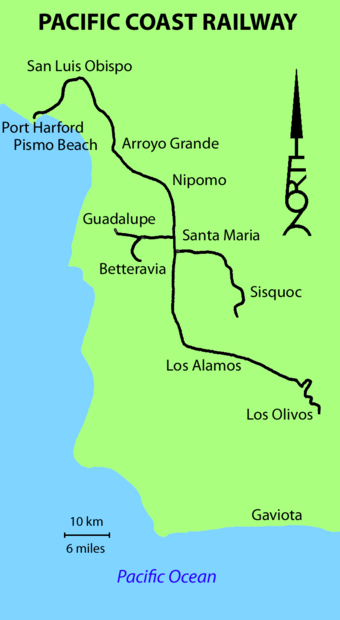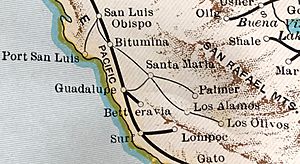Pacific Coast Railway facts for kids
 |
|
| Overview | |
|---|---|
| Headquarters | San Luis Obispo |
| Locale | California |
| Dates of operation | 1873–1941 |
| Technical | |
| Track gauge | 3 ft (914 mm) |
| Length | 76 miles (122 km) |
The Pacific Coast Railway was a special kind of train line. It used a 3 ft (914 mm) narrow gauge track. This means the tracks were closer together than regular train tracks. This railway operated along the beautiful Central Coast of California.
It started with a 10-mile (16 km) line. This line connected San Luis Obispo to Avila Beach and Port Harford. Over time, the railway grew. It stretched south to Santa Maria and Los Olivos. It also had smaller branch lines going to places like Sisquoc and Guadalupe.
Contents
How the Railway Began
The Santa Maria Valley in California was a bit cut off from other areas. Mountains like the Santa Lucia Range and Santa Inez Range made travel hard. People needed a way to move goods and travel easily.
In 1869, a long pier called People's Wharf was built at Port Harford. This pier helped transfer goods and people from steamships. These ships traveled between San Francisco and San Diego. In 1873, a man named Ah Louis built a small tramway. It used horses to pull cars between Port Harford and Avila Beach.
From Tramway to Steam Trains
In 1875, the Pacific Coast Steamship Company took over. They replaced the horse tramway with a steam-powered train line. This was the San Luis Obispo & Santa Maria Valley Railroad. It used 3 ft (914 mm) narrow gauge tracks.
The first trains had ten boxcars and one passenger car. They were pulled by two locomotives. One was named "Avila" and the other "John Harford." San Luis Obispo quickly became a busy center. It received goods and sent out farm products like hay, grain, and dairy.
The train line grew longer. It reached Arroyo Grande in 1881 and Santa Maria in 1882. More locomotives were added to pull a fleet of 120 new flatcars. A new, much larger wharf was built at Port Harford. It had tracks running its entire length.
Changes and Growth
In 1882, a company called Oregon Improvement Company took control. They renamed the railway the Pacific Coast Railway. The line was extended to Los Alamos. Then, in 1887, it reached Los Olivos.
A big fire in 1892 caused a lot of damage in San Luis Obispo. It destroyed train repair shops and many cars. But the railway was doing well enough to fix everything quickly.
When the Southern Pacific railway reached San Luis Obispo in 1894, fewer passengers used the Pacific Coast Railway. However, the Pacific Coast Railway still carried most of the freight from the Santa Maria Valley. In 1899, a new branch line was built. It went from Santa Maria to a sugar beet factory in Betteravia.
Busy Years and Oil Discoveries
The railway became even busier with farming products. Then, oil was discovered in the Santa Maria Valley. This was a huge boost! By 1902, the railway's engines were changed to burn oil. They also started carrying oil in tanks on their flatcars.
The railway needed more powerful trains to move all the oil. Five new, strong locomotives were added by 1906. The number of freight cars grew to two hundred.
Some parts of the railway became electric. The Betteravia branch was electrified in 1906 and extended to Guadalupe in 1909. Another electric branch was built in 1910 to serve an oil refinery. Three electric locomotives and a special passenger car worked on these electric lines.
The Railway's Final Years
Over time, farming in Santa Maria Valley changed. Farmers started growing produce that could go directly onto larger Southern Pacific trains. The sugar beet factory closed in 1927. Electric train operations ended in 1928, though steam trains still ran sometimes.
The railway's profits peaked in 1921. But as cars became more popular, fewer people rode the trains. There was a brief increase in business in 1928 and 1929. The railway helped haul gravel for building U.S. Route 101. They even bought two used locomotives to help with this work.
Service to Los Olivos became less frequent and ended in 1933. Many parts of the railway were taken apart in the late 1930s. In 1938, one locomotive was destroyed in an accident. The last passenger cars were sold.
The United States Navy bought the railway's boxcars in 1941. This was when the Pacific Coast Railway stopped operating. One locomotive went to the Oahu Railway and Land Company in Hawaii. Most of the remaining equipment was scrapped by 1948. However, caboose number 2 has been saved and is now at the California State Railroad Museum.
Locomotives of the Pacific Coast Railway
The Pacific Coast Railway used many different types of locomotives throughout its history.
Steam Locomotives
| Number | Type | Builder | Built | Notes |
|---|---|---|---|---|
| 1 | 2-4-2t | Baldwin Locomotive Works | 1875 | Later sold to another railway. |
| 2 | 4-4-0 | Baldwin Locomotive Works | 1876 | Destroyed by fire in 1896. |
| 3 | 4-4-0 | Thos. Paul & Sons | 1881 | Rebuilt as #104 in 1899. |
| 4 | 2-6-0 | Thos. Paul & Sons | 1881 | Rebuilt as #102 in 1898. |
| 5 | 2-6-0 | Thos. Paul & Sons | 1881 | Rebuilt as #103 in 1898. |
| 6 | 4-4-0 | Baldwin Locomotive Works | 1883 | Destroyed in an explosion in 1904. |
| 101 | 2-6-0 | Baldwin Locomotive Works | 1893 | Scrapped in 1924. |
| 102 | 2-6-0 | Rebuilt | 1898 | Originally #2. Scrapped in 1912. |
| 103 | 2-6-0 | Rebuilt | 1898 | Originally #4. Scrapped in 1905. |
| 104 | 4-4-0 | Rebuilt | 1899 | Originally #3. Scrapped in 1912. |
| 105 | 2-8-0 | Baldwin Locomotive Works | 1904 | Scrapped in 1943. |
| 106 | 2-8-0 | Baldwin Locomotive Works | 1904 | Destroyed in a crash in 1938. |
| 107 | 2-8-0 | Baldwin Locomotive Works | 1904 | Used for parts, scrapped in 1948. |
| 108 | 2-8-0 | Baldwin Locomotive Works | 1905 | Scrapped in 1940. |
| 109 | 2-8-0 | Baldwin Locomotive Works | 1906 | Scrapped in 1935. |
| 110 | 4-6-0 | Baldwin Locomotive Works | 1910 | Purchased in 1929 from another railway. Scrapped in 1948. |
| 111 | 4-6-0 | Baldwin Locomotive Works | 1911 | Purchased in 1929 from another railway. Sold to Oahu Railway in 1942. |
Electric Locomotives
| Number | Description | Builder | Built | Notes |
|---|---|---|---|---|
| "Dinky" | Small single truck locomotive | Unknown | Dismantled in 1907. | |
| E1 | Double truck, steeple cab locomotive | Pacific Coast Railway | 1907 | Used parts from "Dinky" and steam locomotive #2. Scrapped in 1938. |
| E2 | Double truck, steeple cab locomotive | Pacific Coast Railway | 1909 | Used parts from steam locomotive #103. Scrapped in 1938. |
| E3 | Combination passenger/baggage car | Cincinnati Car Company | 1912 | Used a gasoline engine later. Scrapped in 1942. |
Gasoline Locomotives
| Number | Description | Builder | Notes |
|---|---|---|---|
| 120 | Switcher locomotive | Plymouth Locomotive Works | Purchased used in 1936. Sold in 1942. |
| 4000 | Light freight service | Pacific Coast | Built from a 1918 Ford Model T. Scrapped by 1942. |
| None | Passenger service | Pacific Coast | Never operated on this railway, sold to another company. |
| Railcars | At least 6 | Unknown | All gone by 1942. |



